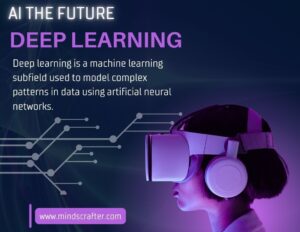
AI deep learning
Unlocking the Power of Deep Learning:
Deep learning is a rapidly growing field of artificial intelligence that is changing how we approach complex problems. With the ability to analyze vast amounts of data, deep learning algorithms have the potential to revolutionize industries ranging from healthcare to finance. However, for those who are new to the field, the complexity of deep learning can be overwhelming. That’s why we’ve created this beginner’s guide to help you unlock the power of deep learning. This article will explore the basics of deep learning, including neural networks, backpropagation, and convolutional neural networks. We’ll also look at some real-world applications of deep learning and provide tips on getting started with your own deep learning projects. By the end of this guide, you’ll have a solid understanding of the fundamentals of deep learning and be ready to take your first steps towards building your own deep learning models.2
How Deep Learning Works?
Deep learning is a machine learning subfield used to model complex patterns in data using artificial neural networks. The structure of the human brain inspires neural networks and consists of layers of interconnected nodes. Each node in a neural network performs a simple mathematical operation on its input and passes the result to the next layer. By stacking multiple layers, neural networks can learn increasingly complex features from data.
The most common type of neural network used in deep learning is the feedforward neural network. In a feedforward neural network, the web passes data in one direction, from the input layer to the output layer. During training, we adjust the weights connecting the nodes in the network to minimize the difference between the predicted output and the actual output..
Deep learning also involves using backpropagation, a method for training neural networks. Backpropagation works by calculating the error between the predicted and actual output and then propagating this error backwards through the network to adjust the weights.
Finally, convolutional neural networks (CNNs) are a specialized type of neural network that is particularly effective for image recognition tasks. CNNs use convolutional layers to extract features from an image and then use fully connected layers to classify the image.
Applications of Deep Learning:
Deep learning has a wide range of applications across industries. We use deep learning in healthcare to analyze medical images and identify patterns that help diagnose diseases. We also use in finance to predict stock prices and detect fraud. Finally, in transportation, we employ deep understanding to develop self-driving cars that can safely navigate roads.
One of the most exciting applications of deep learning is natural language processing (NLP). With the rise of virtual assistants like Siri and Alexa, NLP has become increasingly important. Deep learning algorithms can understand the nuances of human language and generate accurate and natural-sounding responses.
Benefits of Deep Learning in Artificial Intelligence:
The benefits of deep learning are numerous. One of the key benefits is the ability to analyze vast amounts of data in a short amount of time. This feature is particularly useful in industries like healthcare, as they generate large quantities of medical data on a daily basis.
Another benefit of deep learning is the ability to automate complex tasks. This can help businesses save time and money and improve accuracy and efficiency. For example, deep learning algorithms can automate customer service tasks, freeing employees to focus on more complex tasks.
Finally, deep learning has the potential to revolutionize industries by enabling new types of products and services. For example, self-driving cars are only possible because of advances in deep understanding.
The Future of Deep Learning in Artificial Intelligence:
The future of deep learning shines brightly, and with increasing adoption in various businesses and industries, we can anticipate an influx of innovative technological applications. Specifically, fields such as healthcare and finance hold vast untapped potential for the utilization of deep learning.
A crucial aspect that requires attention in future deep learning research is exploitability. Despite the remarkable accuracy of deep learning algorithms, interpreting their decisions can prove challenging. This poses a significant issue in healthcare, where comprehending the rationale behind a diagnosis is vital.
Furthermore, the development of more efficient deep learning algorithms emerges as another focal point. While deep learning already possesses considerable power, its computational demands can be substantial. By creating algorithms that operate more efficiently, a broader range of individuals will be able to leverage this technology.
Finally, as deep learning continues to advance, we can anticipate remarkable prospects in various industries. Addressing challenges related to interpretability and enhancing computational efficiency will further propel the widespread application of deep learning.
Preparing Data for Deep Learning in Artificial Intelligence:
Preparing data for deep learning is one of the most critical steps in the process. Here are some tips to help you prepare your data:
- Clean your data: Make sure your data is free of errors and inconsistencies.
- Normalize your data: Normalize your data to ensure all features have the same scale.
- Split your data: Split your data into training, validation, and testing sets.
- Augment your data: Data augmentation techniques like rotation and flipping can help increase the size of your dataset.
- Use a data pipeline: Use a data pipeline to automate the process of loading and preprocessing your data.
Deep Learning Frameworks:
There are several popular deep learning frameworks, each with its own strengths and weaknesses. Here are some of the most popular deep-learning frameworks:
- Google developed TensorFlow, which is one of the most popular deep learning frameworks known for its scalability and flexibility.
- Facebook developed PyTorch, known for its ease of use and flexibility.
- Keras is a high-level deep learning library built on top of TensorFlow.
- Caffe is a deep learning framework well-suited for image recognition tasks.
- Theano is a deep learning framework known for its speed and efficiency.
Best Practices for Deep Learning:
Here are some best practices to keep in mind when working on a deep-learning project:
- Start with a simple model: Start with a simple model and work your way up to more complex models.
- Regularize your model: Regularization techniques like dropout can help prevent overfitting.
- Monitor your training: Monitor your training metrics, like accuracy and loss, to ensure your model is improving.
- Use early stopping: Early stopping can help prevent overfitting by stopping training when the validation loss stops improving.
- Experiment with hyperparameters: Hyperparameters like learning rate and batch size can greatly impact your model’s performance. Experimenting with different values can help you find the best settings for your project.
Common Challenges in Deep Learning (Artificial Intelligence):
Deep learning is a complex field, and there are many challenges that you may encounter along the way. Here are some of the most common challenges:
- Overfitting occurs when your model performs well on the training data but needs improvement on the validation data. This can be prevented by using regularization techniques like dropout.
- Data quality: Deep learning models are only as good as the data they are trained on. If your data is noisy or poorly quality, your model’s performance will suffer.
- Computational resources: Deep learning models can be computationally expensive to train. If you need access to a powerful GPU, training your model may take a long time.
- Interpretability: Deep learning models can be challenging to interpret. This can be a problem in fields like healthcare, where it is essential to understand how a diagnosis was made.
- Hyperparameter tuning: Finding the best hyperparameters for your model can be time-consuming and require much experimentation.
Conclusion:
Deep learning is a powerful tool that has the potential to transform industries and solve complex problems. However, getting started with deep learning can be daunting. By following the tips and best practices outlined in this guide, you’ll be well on your way to building your own deep-learning models. Remember to start small, choose a well-documented deep-learning framework, and experiment with different hyperparameters. With practice and persistence, you’ll soon be unlocking the power of deep learning.

Pingback: Reinforcement Learning